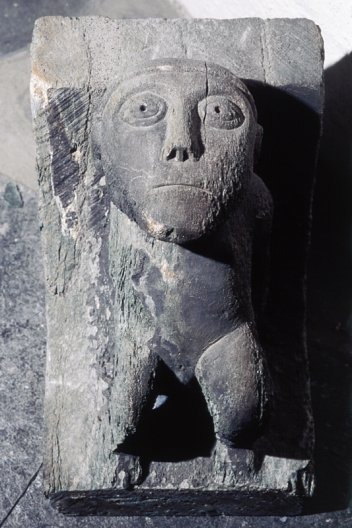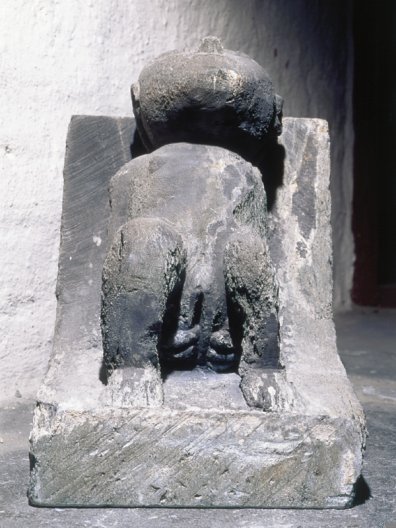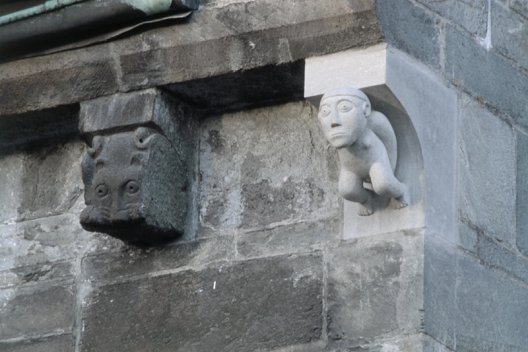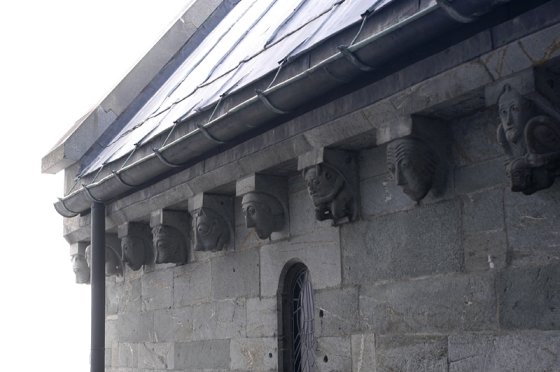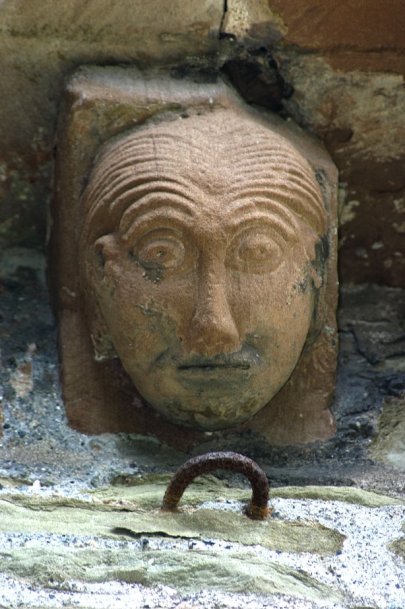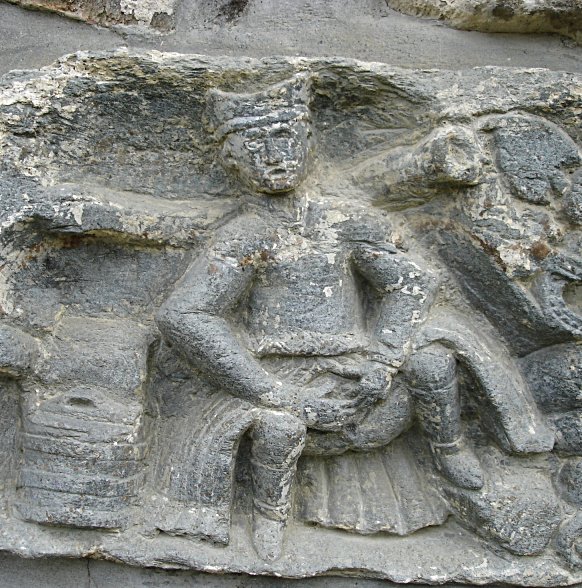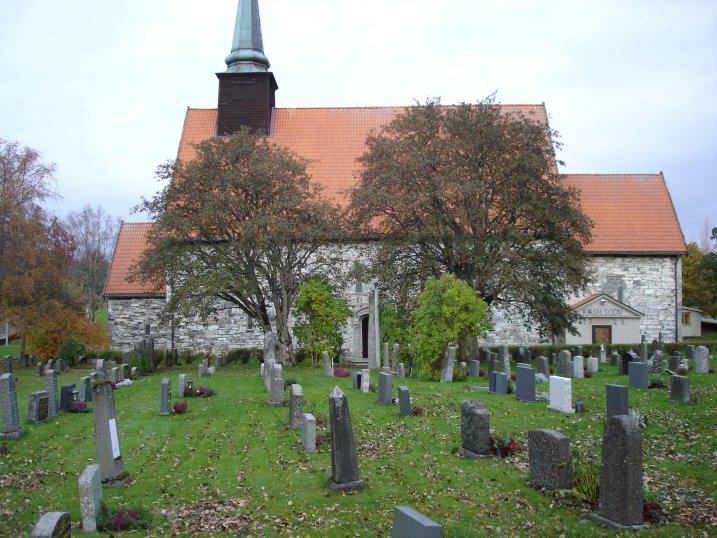International
Marienhafe, Germany
These male and female carvings date from the 13th century and reside in the tower Museum attached to the church of St. Marien in Brookmerland, East Frisia, Germany.
Both figures are spread legged with their hands on their knees and are unequivocally exhibitionist. One curious features is that they have their heads forward on the chest. This makes them look somewhat like Blemya figures. The female has small breasts located either side of its chin. Unfortunately the male figure was only on display as a drawing and has a modest set of genitals on display.
The present day church is a brick building which replaced the original church in 1829. The museum houses a collection of friezes and other sculpture from the remains of the 1829 demolition. As you can see from the lithographs below there are definite echoes of Romanesque style in the original church which makes the presence of the two exhibitionist figures more understandable.
All photographs used with the permission of the original photographer.
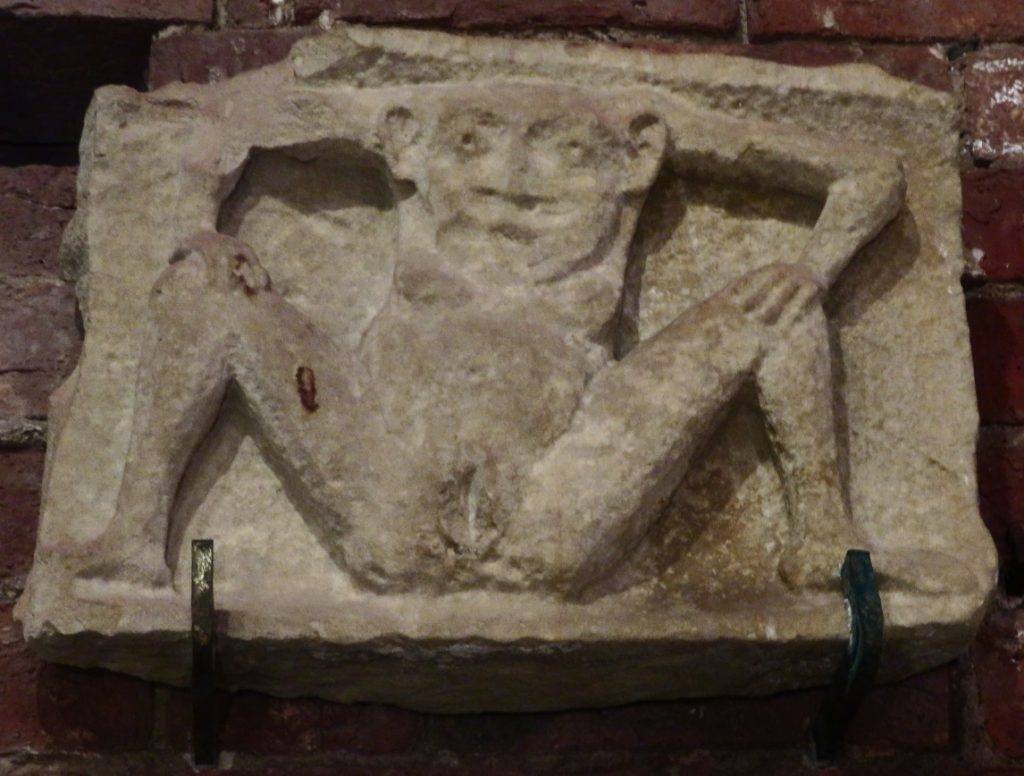
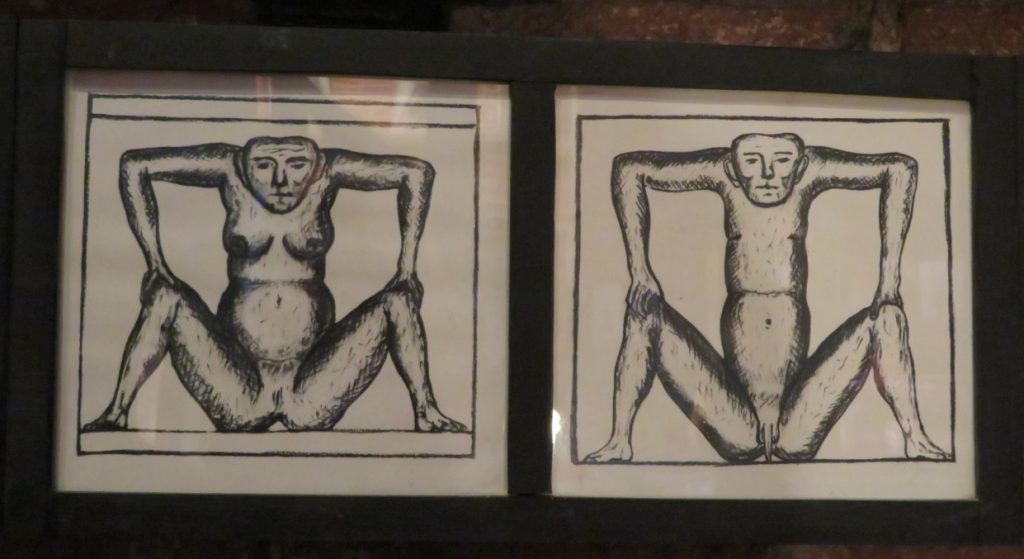
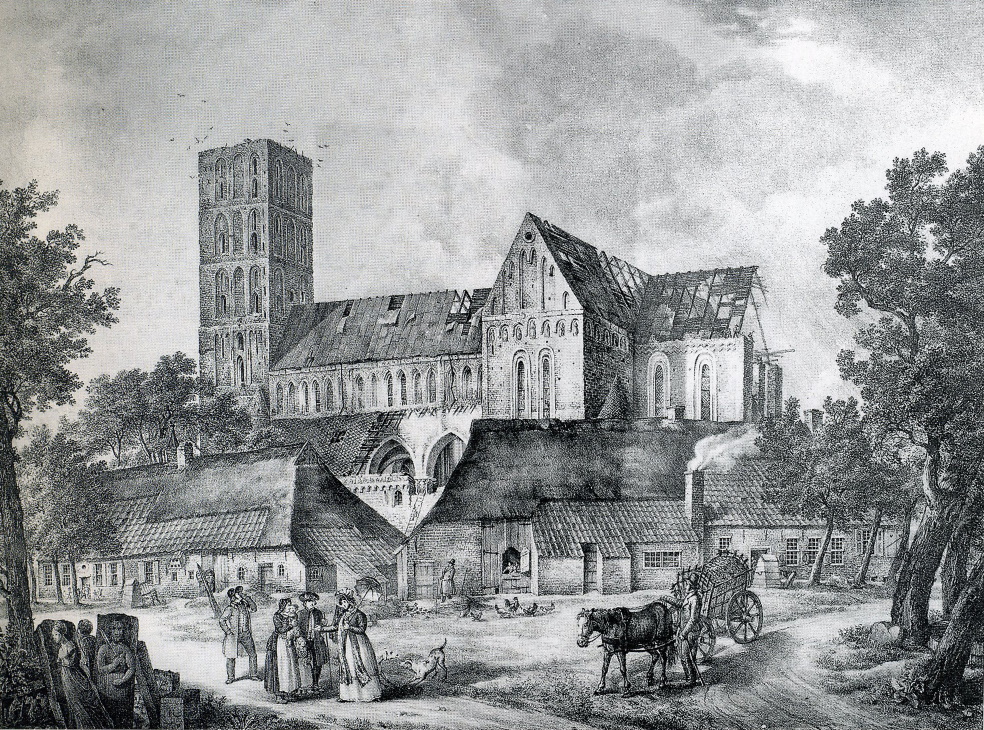
(Lithograph by D. Bendixen). There appear to remains of an older building in the middle of the image and there and some sculpture is still visible on the church. Note the sculptural gravestones in the bottom left hand corner. Image in public domain
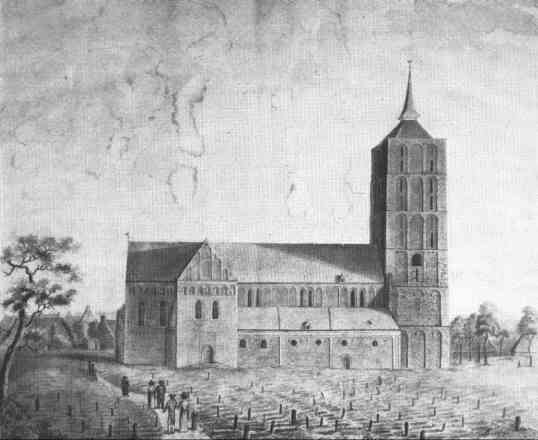
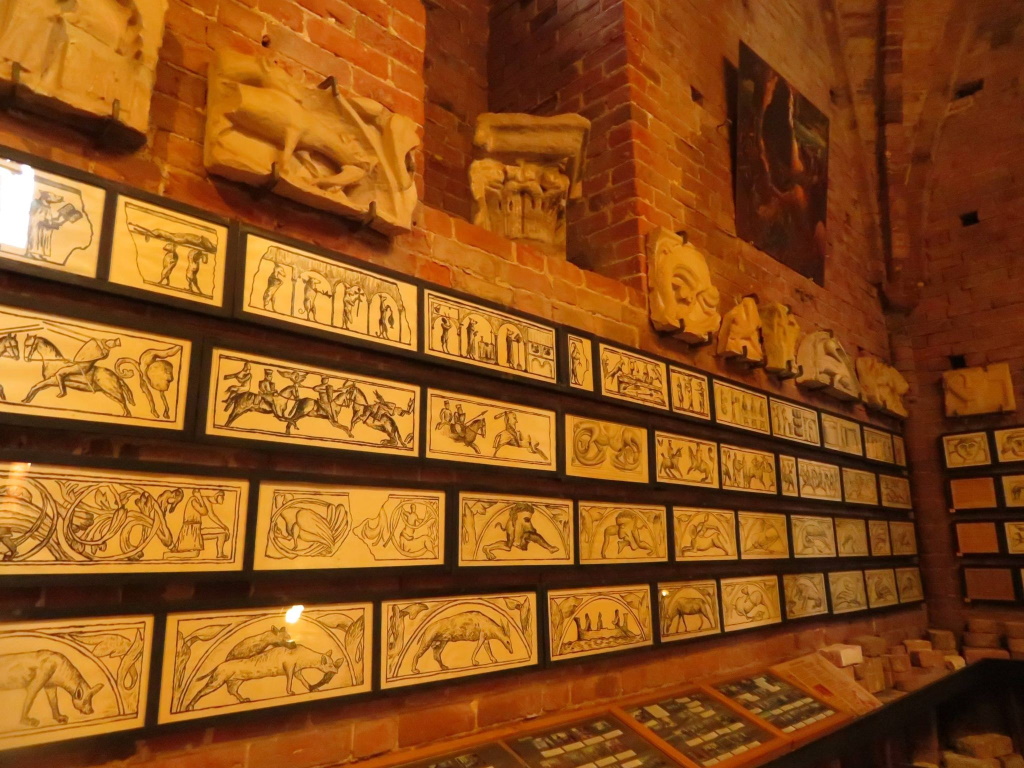
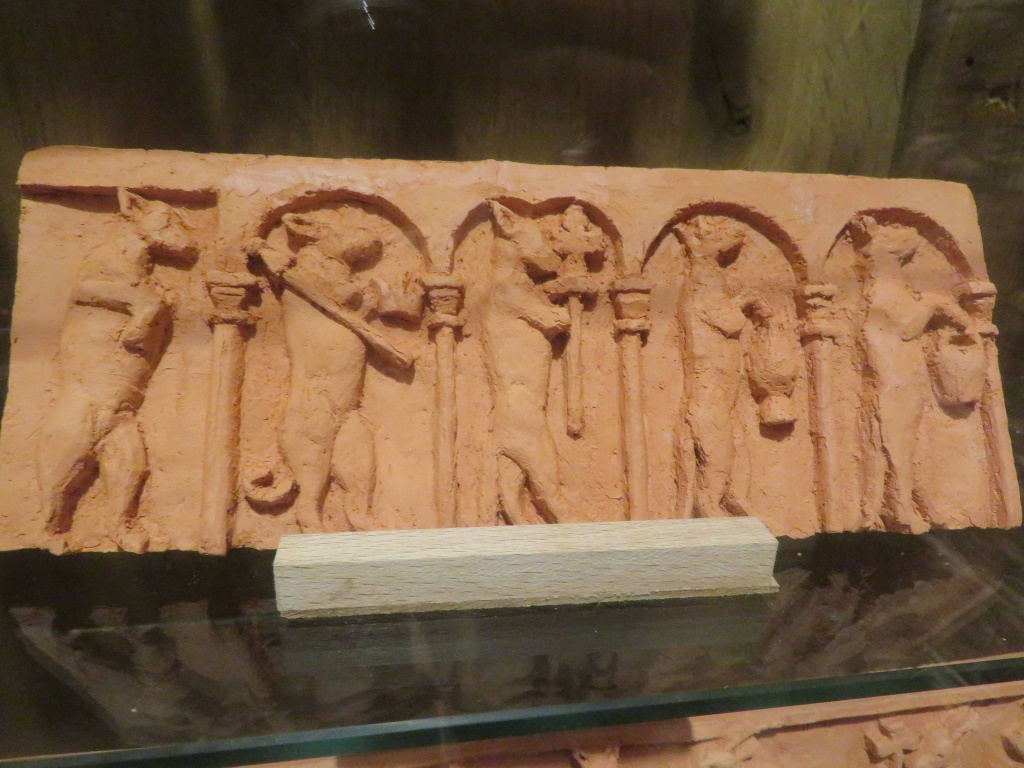
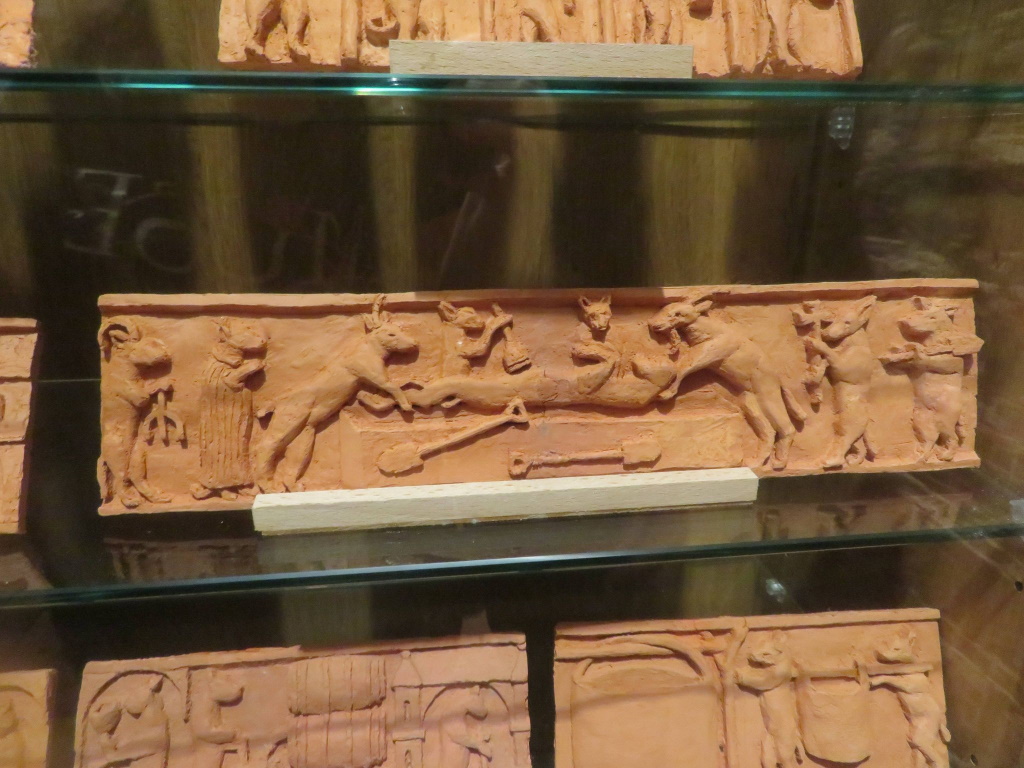
Access to the museum https://www.stoertebekerland.de/seite/372292/st%C3%B6rtebekerturm-marienhafe.html
Jersey
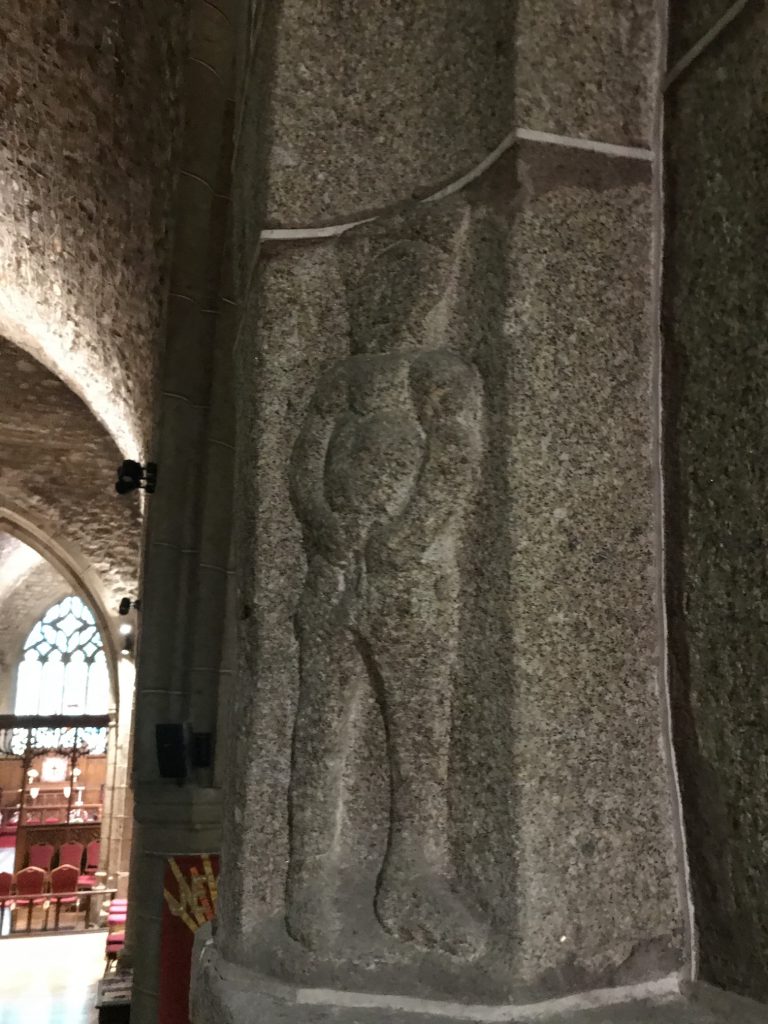
This figure resides in the church of St Savior’s in Jersey. St Saviours dates from 11th century with a church recorded here in 1087. There is indication that there may have been a church here as early as the 9th century. The figure is standing with both feet pointing to the right. It is quite thickset with large upper and lower arm and a plump belly. The hands point at the groin to a crudely incised vulva which does not go all the down to the crotch. The face is basic and the head is surmounted by what appears to be a headress or hat This is trapezoidal in shape and fits closely to the head. Headgear is not unknown on Sheela Na Gigs and this adds another figure to list. The quality of the sculpture is quite crude again not uncommon with Sheelas. Unfortunately this figure sits in isolation and there is no other sculpture to compare it to. It has spent most of it’s time hidden begin a wall which may go some way to explaining its survival.
Thanks go to Rosalind Le Quesne who first suggested this figure as Sheela na Gig in the Société Jersiaise Annual Bulletin 2019 (ISSN 0141-1942) and kindly supplied the photograph above and the excellent 3d model of the figure below..
Location
Trondheim Norway
The Figure
This figure used to reside on the external corner of the South transept of the Nidarosdomen Cathedral in Trondheim, Norway. It was replaced in 1992 with a modern copy and the original is now on display in the Archbishops Palace Museum attached to the cathedral. The sheela was published by Jørgen Andersen in the artcle “Konsollernes verden” in Kunst og Kultur Nr. 1 in 1996. This figure is one of three alleged sheela na gigs in Norway, The other carvings are at Stiklestad and Sakshaug although the Sakshaug carving is somewhat suspect as it appears to be more of a pine cone than sheela na gig. This sheela was in all likelihood carved by an English sculptor as we shall see below.
The History of the Cathedral
King Olaf Haraldsson (also known as Olav) now St Olaf was killed at the battle of Stiklestad in 1030. Tradition has it that the high altar of the cathedral marks the spot where he was buried. In 1031 the King was declared a saint and pilgrims started to visit his grave. Work started on building the first stone church at the site around 1070. This building was commissioned by King Olav the Gentle the nephew of St Olav and it is thought that English craftsmen were employed in its construction. Parts of the cathedral are in the Early English style.
For more information on English influence in the area see the page on Stiklestad.
English and French Influence
The cathedral bears some striking similarities to Lincoln cathedral which it strongly resembles. The romanesque corbels on the church also seem to be English in origin as can be seen below. A broken dragon head hood terminal now housed in the Archbishops museum is very similar to those found England. It also thought that English masons and artists had a hand in building most of the 20 or so Romanesque churches in the Trondelag area.
The Sheela na gig
As you can see from this angle the figure is unequivocally exhibitionist with one finger seemingly insterted into the vulva. However when viewed from the front which is the angle the corbel is most likely to be seen from it would seem that the vulva would be hidden in shadow. Kjartan Hauglid who supplied the pictures for this page assures me that the exhibitionist nature of the carving is visible from the ground. Nevertheless this figure is definitely one of the more modest sheelas unlike the “megavulvic” examples at Kilpeck and Oaksey.
Being “only visible from below” is a feature of some other sheelas, for instance the ones at Stoke Sub Hamdon and on St John’s at Devizes can only be seen to be exhibitionist from directly below. This begs the question that if figure is not overtly exhibitionist then why are the sexual features present at all? From the photograph below it seems that even when it was newly carved the height of the sculpture and the butress below it would have prevented its exhibitionist nature from being seen. Non overt or overly highly placed sheela na gigs would seem to be detract from the “warning against lust” theory put forward by Anthony Weir and James Jerman. If the figure cannot be seen to be exhibitionist then how does serve as a method of instruction? Conversely these non overt sheelas may be being used in an apotropaic way to avert evil in somewhat more quiet and non obtrusive manner than their more blatant sisters. The figures at Oxford and Stanton St Quintin were and are high up and barely visible from below.
Thanks go to Kjartan Hauglid for supplying the photographs and much of the information about the sheela.
All photos copyright Kjartan Hauglid 1996
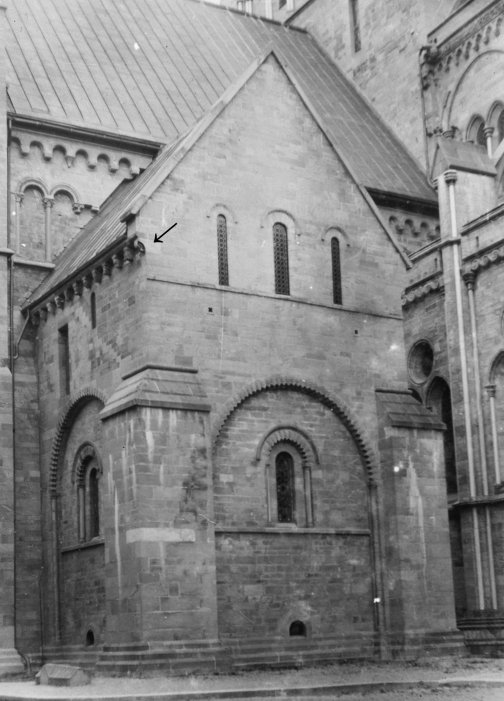

Location
Stiklestad Norway
The Figure
If you have any doubts to the international nature of exhibitionist religious carvings then this figure should go some way to persuading you.
This figure lies on the church of St Olaf, at Stiklestad in Trondelag, Norway. It is one of around 20, 12th century stone churches in the area. The exact date of the church’s construction is not known but it is thought to date from around 1180 which fits in well with dates for British exhibitionist figures. The Nidarosdomen cathedral at Trondheim was being built around this time which also carries an alleged female exhibitionist figure on the corbel table. There are many similarities between Lincoln Cathedral in the UK and the Nidarosdomen and it is thought that English masons were employed in its construction. This also seems to apply to the sculptors. A number of elaborate soapstone carvings on smaller churches in the area, carry the same signatures of masons who worked on the Cathedral.
The figure is part of a series of Romanesque fragments which have been reset into the present church wall.
Is this a Sheela?
While the figure is undoubtedly exhibitionist it would be hard to call it female. However it does seem to lack male genitals and there is a distinct hole beneath the hands. The figure is richly attired and the pleated “skirt” would seem to suggest a male along with the boots. (For a similar “skirt” see the warrior figures on the door at Kilpeck. The lack of female attributes would seem to suggest that this may be an anus shower rather than sheela na gig. Saying that another interpretation is that a male figure is being shown with female genitalia suggesting possible satirical element.
Thanks go to Eskil Følstad of the Stiklestad National Culture Centre for supplying the pictures and information on this figure.
St Olaf, The Perpetual King of Norway
King Olaf Haraldsson (Olaf II) was king in Norway between 1015-1030. King Olaf is a good example of the international state of religion and politics during the 11th and 12th centuries. Olaf has strong ties with England as he spent a number of years there fighting the Danes. After being baptised in Rouen he returned to Norway and brought with him bishops from England and Germany. Bishop Grimkell came from England and it was he that eventually organised the beatification of the King.
At his death at the battle of Stiklestad he was more or less fighting his own subjects. His son Magnus the Good ruled Norway after a brief hiatus and its thought that through his efforts the cult of St Olaf was promoted and came to prominence. A number of churches can be found in England and Ireland dedicated to St Olaf (also spelt Olave) especially in area with Norse connections. There are ones in London, York, Dublin and Waterford.
All photos copyright Eskil Følstad, Stiklestad National Culture Centre
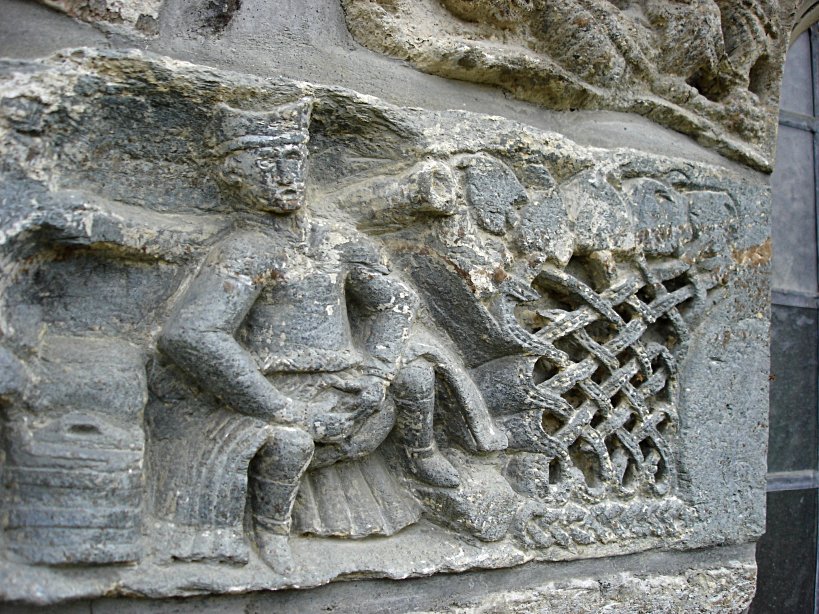
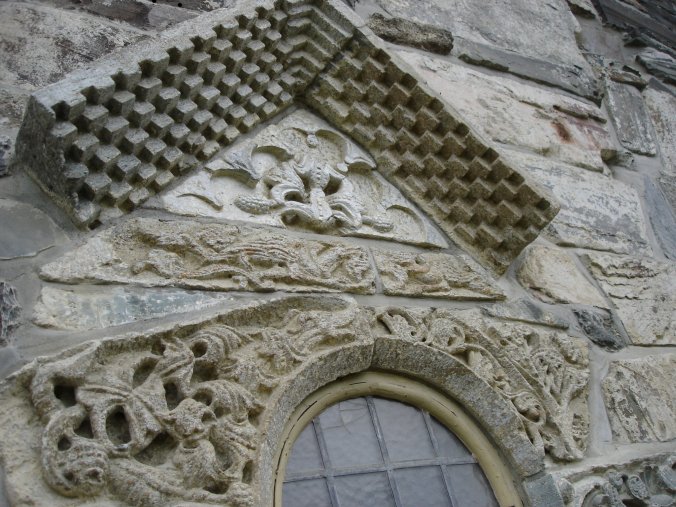

Location
Porta Tossa Milan

The carving was removed from its original position believed to be above one of the gates to the to the city by Cardinal Carlo Borromeo in the 1500s who wanted his eyes “only to gaze on the stars of Heaven”.
The relief is said to date from around 1185 and there are a number of theories about who the carving represents all of which are connected to Frederick Barbarossa who sacked the city in 1162.
This figure now in the Castello Sforzesco, Museum of Ancient Art in Milan.
Beatrice I, Countess of Burgundy wife of Frederick Barbarossa
This interpretation comes from the artist Francesco Pirovano …, Silvestri in 1822[1]. He holds that it is a satirical depiction of the wife of Frederick Barbarossa who had razed Milan. There is a further piece of Milanese folklore about the empress Beatrice. During the seige of the city in 1158 the empress was captured by the Milanese and was humiliated by being paraded around the city on a donkey. When Barbarossa captured the city he took his revenge on the magistrates by forcing them to take a fig from a donkey’s anus using only their teeth.
The Eastern Empress Leobissa
Another story holds that the Porta got its name after the Milanese delegation to the Eastern Empress in Constantinople Leobissa was refused their requests for financial assistance following Frederick Barbarossa’s sack of Milan in 1162. The Milanese erected the marble bas-relief to spite the empress and affixed it to this Easternmost and thus Constantinople-facing gate as a further insult.
An exhibitionist who saved the city or defied an army
Canon Carlo Torre wrote another explantion[1] of the figure which again includes Barbarossa… When Barbarossa was about to sack the city an unnamed woman standing on a balcony near the eastern gate performed the same gesture. Barbarrosa seeing this ordered his men to lay down their arms. The statue was carved to commemorate the woman and the “shaming” of Barbarossa. This motif is interesting as it parallels a much later story in the Irish Times where a woman averted violence between a warring group of men by showing her sex.
Unfortunately the inscription accompanying the sculpture, much consumed, there is a great help. On the stone you can read only “(…) EST PORT T (…) CTONSE”, difficult integration and translation.
1 https://www.facebook.com/photo.php?fbid=584192658308402&set=a.171081449619527.43407.100001530205203&type=1&fref=nf
http://en.wikipedia.org/wiki/Frederick_I,_Holy_Roman_Emperor#cite_note-85
Images of Lust Page 47
http://www.portatosa.it/en/legend/
Gelsted a Sheela na gig in Denmark
Evidence has come to light of Romanesque Sheela Na Gig and male exhibitionist type figures in Denmark
The figures are on the base of a font in the church at Gelsted Denmark
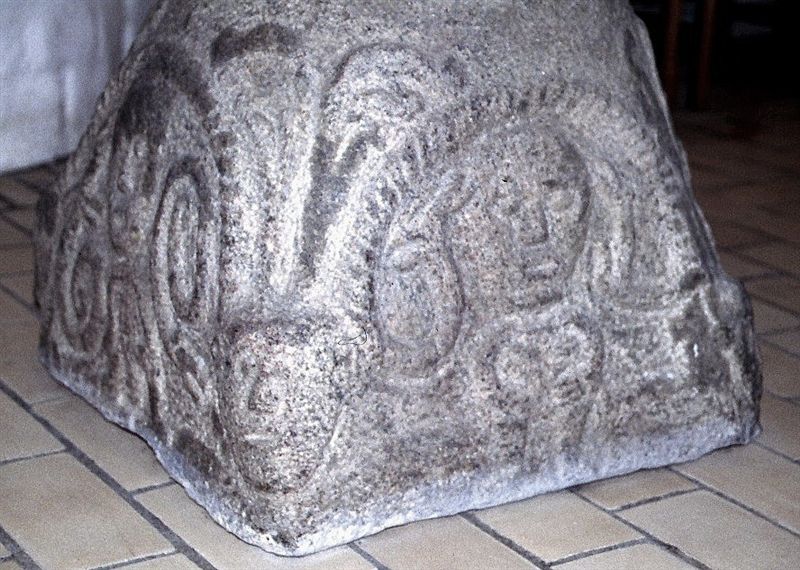
Hideko Bondesen – http://www.nordenskirker.dk/ [CC BY-SA 2.5 or CC BY-SA 2.5], via Wikimedia Commons
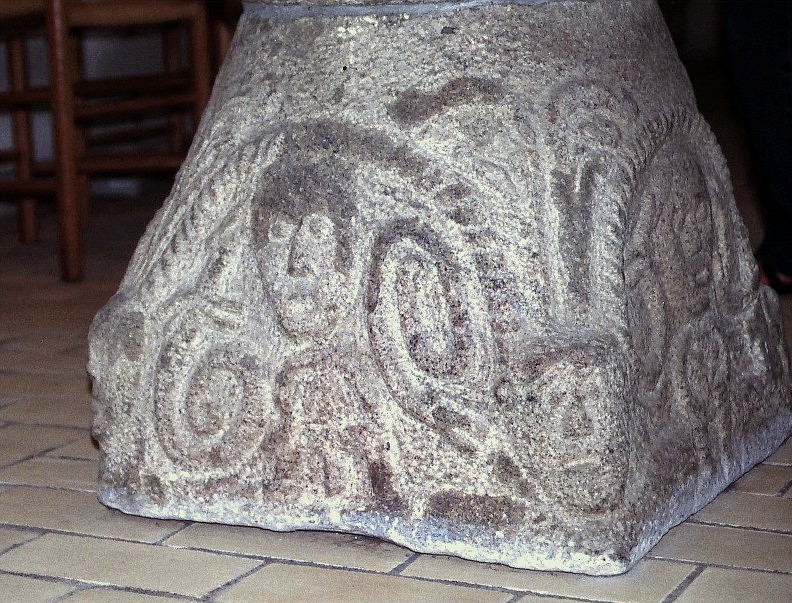
Hideko Bondesen – http://www.nordenskirker.dk/ [CC BY-SA 2.5 or CC BY-SA 2.5], via Wikimedia Commons
http://www.nordenskirker.dk/Tidligere/Gelsted_kirke/Gelsted_kirke.htm
